The headline inflation of prices in Davao de Oro Province increased to 12.5 percent in September 2022 from 10.2 percent in August 2022. This is the highest recorded inflation of prices since January 2019. Inflation of prices in September 2021 was lower at 3.9 percent. The average inflation for the first nine months of the year stood at 8.6 percent. (see Table 1 and Figure 1)
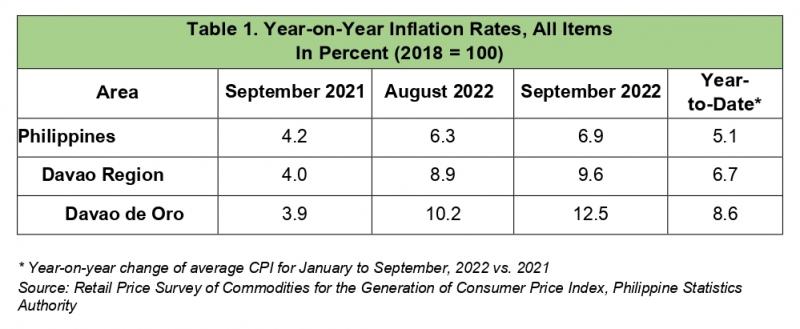
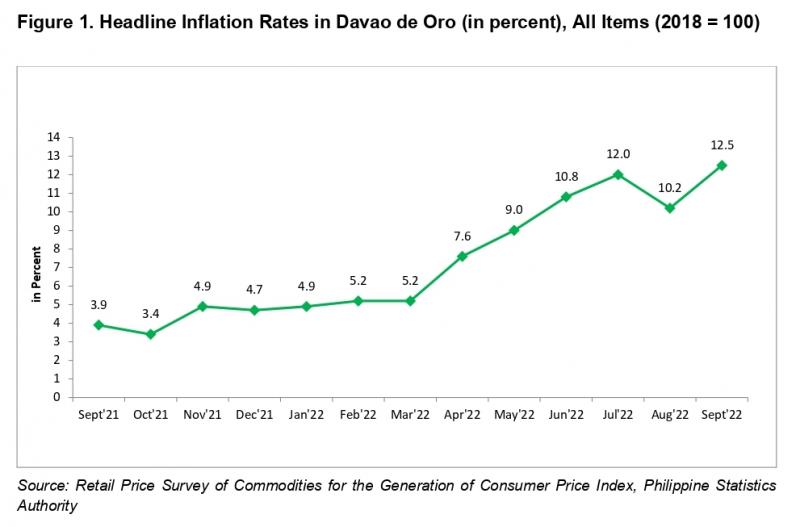
The increase in the province’s inflation was mainly brought about by the higher annual increase in the index of Food and Non-Alcoholic Beverages at 10.6 percent; Housing, Water, Electricity, Gas and Other Fuels at 19.1 percent; and transport at 20.2 percent. (see Table 2)
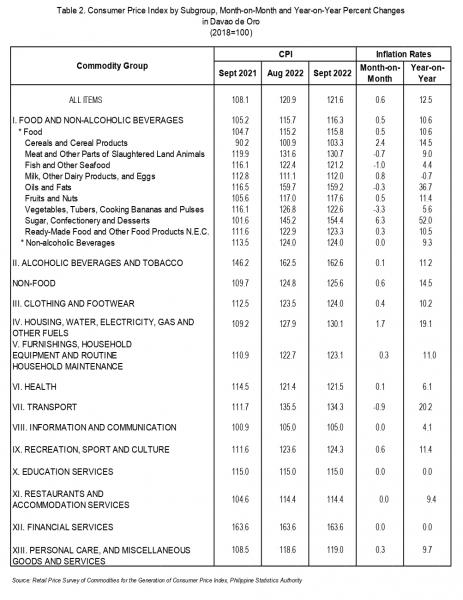
Also contributing to the uptrend in the overall inflation during the period were the higher annual increments in the indices of the following commodity groups as compared with their previous month’s inflation rates:
a. Recreation, Sport and Culture, 11.4 percent;
b. Furnishings, Household, Equipment and Routine, 11.0 percent;
c. Clothing and footwear, 10.2 percent;
d. Personal Care, and Miscellaneous Goods and Services, 9.7 percent; and e. Health, 6.1 percent.
Financial Services commodity group remains zero percent inflation rate for the six successive months, while the Education Services group remains at zero percent inflation rate since July 2020. Restaurants and Accommodation Services group also remains at 9.4 percent for the five successive months.
Food and Non-Alcoholic Beverages group shared the highest contribution for the month inflation rate at 5.4 points (43.0 percent). The major contributor to the inflation from the sub- items of this group are Corn at 3.9 points (36.4 percent), Meat and other parts of slaughtered land animals at 1.3 points (12.1 percent), and Sugar, confectionery and desserts at 1.3 points (11.8 percent). (see Table 3).
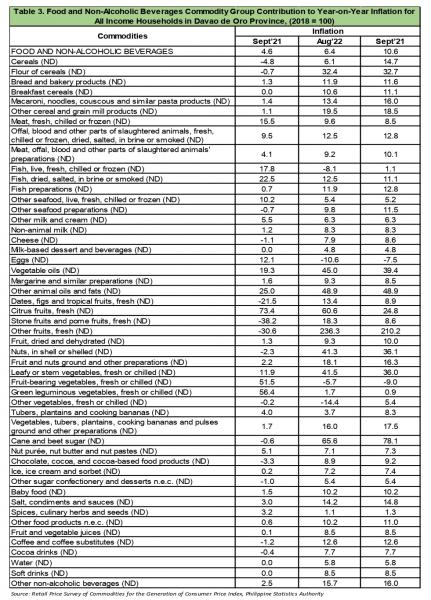
The second highest contributor for September 2022 inflation rate is the Housing, Water, Electricity, Gas, and Other Fuels commodity group with a contribution of 3.4 points (27.1 percent) among all items. Under this group, electricity ranked first with a contribution of 65.3 percent, followed by actual rentals paid by tenants for main residence and wood fuel, including pellets and briquettes with a contribution of 25.2 and 2.9 percent, respectively (see Table 4).
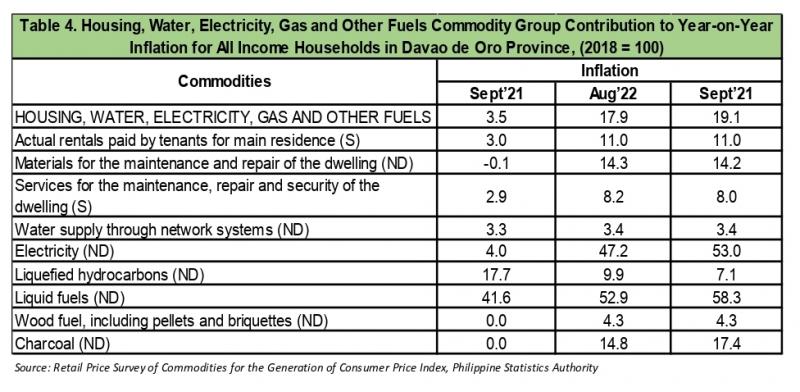
Transport commodity group ranked third with a contribution of 1.7 points (13.5 percent). Under this group, gasoline has the highest contribution to inflation at 48.1 percent, followed by other passenger transport by road and passenger transport by bus and coach with a contribution of 21.9 and 15.0 percent, respectively (see Table 5).
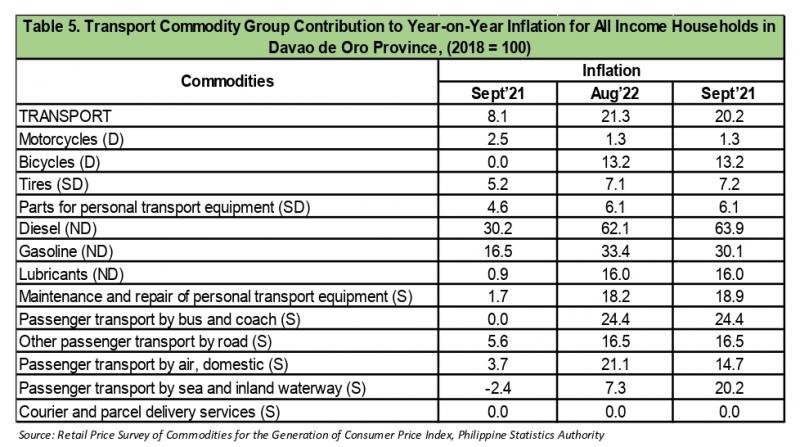
Below is the inflation rate trend of Davao de Oro Province since the rebasing of market basket with year 2018 as the base year. (see Table 6)
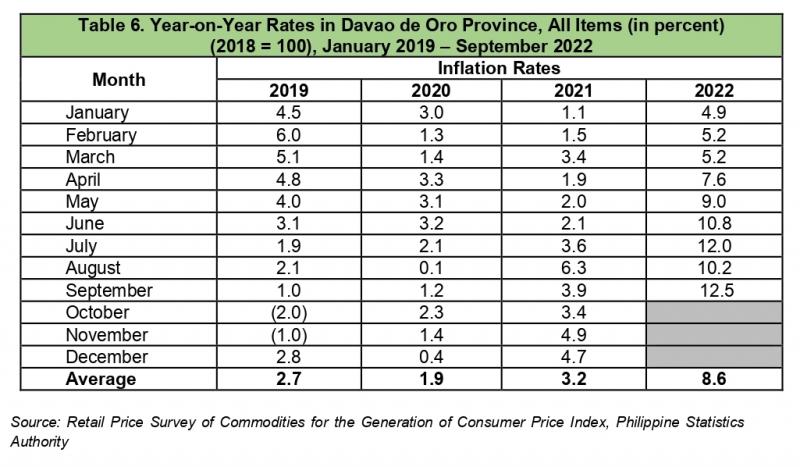
Consequently, the Purchasing Power of Peso (PPP) based on year 2018 in Davao de Oro Province is equivalent to 0.82 in September 2022. (see Figure 2)
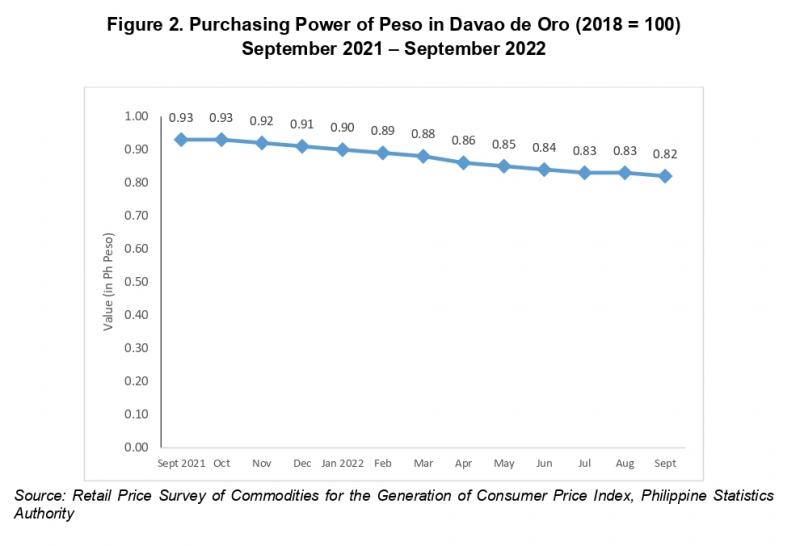
TECHNICAL NOTES:
Price – is the amount or value paid in exchange for the commodity or a service rendered. Retail/Consumer Price – refers to the price at which a commodity is sold in small quantities for consumption.
Market Basket– a term used to refer to a sample of goods and services that are commonly purchased and bought by an average Filipino household.
Consumer Price Index (CPI) – it is an indicator of the change in the average retail prices of a fixed basket of goods and services commonly purchased by an average Filipino household. It shows how much on the average, prices of goods and services have increased or decreased from a particular reference period known as base year.
Inflation Rate – is an indicator derived from the CPI. It refers to the annual rate of change or the year-on-year change of the CPI expressed in percent. Inflation is interpreted in terms of declining purchasing power of money.
Weight– a value attached to a commodity or group of commodities depending on the magnitude of its contribution to the index.
Base Period – a reference date at which the index is equal to 100. Base year is 2018. Index Methodology– a Laspeyre’s formula: fixed base year and weights.
Purchasing Power of the Peso (PPP) – the measure of how much the peso in the base period is worth in the current period.
Percentage Change– is a simple mathematical concept that represents the degree of change over time. It is used for many purposes in finance, often to represent the price change of a security.
Headline Inflation– measures changes in the cost of living based on movements in the prices of a specified basket of major commodities. It refers to the annual rate of change or the year-on-year change in the Consumer Price Index (CPI).
